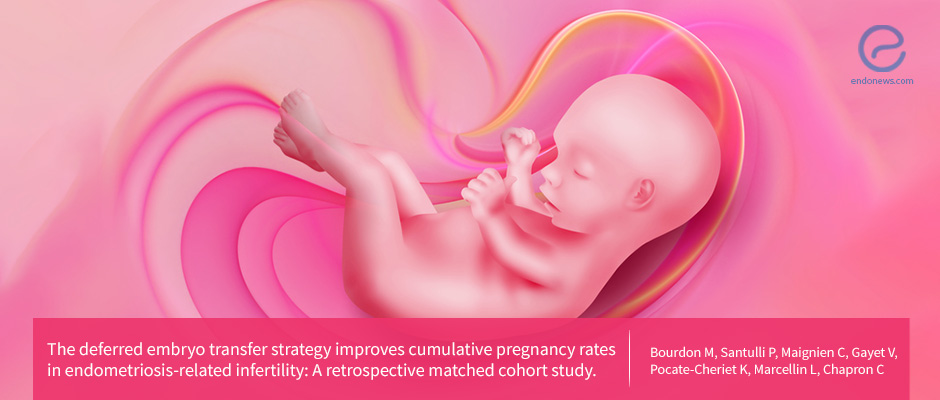Most Effective Embryo Transfer Strategy
May 3, 2018
Deferred frozen-thawed embryo transfer (Def-ET) has been found to increase Assisted Reproduction Technology success when compared to Fresh embryo transfer.
Key Points
Highlights:
- The researchers want to compare the outcomes of cumulative assisted reproduction technology (ART) with regards to fresh and deferred frozen-thawed embryo transfer (Def-ET). They are specifically focusing on infertile women with endometriosis.
Importance:
- At least one-third of women with endometriosis are rendered infertile by the disease. Thus, it is imperative to search for a treatment option that would allow women with endometriosis the opportunity to start a family if they so desire.
What’s done here?
- This is a matched cohort study. The participants were 135 women with endometriosis who were scheduled to undergo a Def-ET cycle and 135 women with endometriosis who were scheduled to undergo a fresh-ET cycle.
- The participants were then matched based on age, the number of prior ART cycles, and endometriosis phenotype. Endometriotic lesion phenotype was classified as superficial peritoneal endometriosis (SUP), ovarian endometrioma (OMA), or deeply infiltrating endometriosis (DIE).
- The participants underwent ovarian stimulation and oocyte retrieval. Male semen samples were also collected. The researchers assessed fertilization of the oocyte 17-18 days after oocyte insemination or injection.
- The researchers cultured the embryos and evaluated their morphology. If the blastocyst was approved it was cryopreserved, then the embryos were thawed and warmed on the day of transfer, on the 4th and 5th day of progesterone exposure respectively.
- All the participants were given a progesterone and estradiol treatment.
Key results:
- The Def-ET group had a higher rate of cumulative clinical pregnancy. That rate was 43% compared to the fresh ET group where the rate was 29.6%.
- The cumulative ongoing pregnancy rate for the Def-ET group was 34.8% and for the fresh-ET group, it is 17.8%.
Limitations of the study:
- The authors list the facility from which the patients were recruited as a limitation of the facility may only see extreme endometriosis cases.
- Another limitation is the fact that the women in the fresh ET group had more prior history of surgery than the Def-ET group. The authors believe that this can affect ovarian response.
- The last limitation delineated by the researchers is the fact that this is a preliminary cohort study. There is a great potential for bias.
Lay Summary
Bourdon et al., a group of scientists mainly from the Centre Hospitalier Universitaire, recently published a paper in PLOS ONE titled “The deferred embryo transfer strategy improves cumulative pregnancy rates in endometriosis-related infertility: A retrospective matched cohort study.” This study wanted to compare cumulative assisted reproduction technology (ART) outcomes in women with endometriosis who undergo fresh and deferred frozen-thawed embryo transfer (Def-ET).
The researchers recruited and matched women with endometriosis who are scheduled for a fresh-ET cycle with those scheduled for a Def-ET cycle.
Data on pregnancy rates were collected in the two groups. The data from this project was subject to statistical analysis.
The results of the study show increased cumulative clinical pregnancy and cumulative ongoing pregnancies rates in the Def-ET group compared to the fresh-ET group.
In conclusion, this study proves that Def-ET is the better option for women with endometriosis who are trying to optimize their ART success rate.
Research Source: https://www.ncbi.nlm.nih.gov/pubmed/29630610
embryo transfer assisted reproduction technology Def-ET fertility

